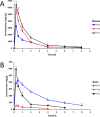Mass Spectrometry Imaging Demonstrates the Regional Brain Distribution Patterns of Three First-Line Antiretroviral Drugs
- PMID: 31867510
- PMCID: PMC6921606
- DOI: 10.1021/acsomega.9b02582
Mass Spectrometry Imaging Demonstrates the Regional Brain Distribution Patterns of Three First-Line Antiretroviral Drugs
Abstract
HIV in the central nervous system (CNS) contributes to the development of HIV-associated neurological disorders (HAND), even with chronic antiretroviral therapy. In order for antiretroviral therapy to be effective in protecting the CNS, these drugs should have the ability to localize in brain areas known to be affected by HIV. Consequently, this study aimed to investigate the localization patterns of three first-line antiretroviral drugs, namely, efavirenz, tenofovir, and emtricitabine, in the rat brain. Liquid chromatography-tandem mass spectrometry (LC-MS/MS) and matrix-assisted laser desorption ionization mass spectrometry imaging (MALDI-MSI) were utilized to assess the pharmacokinetics and brain spatial distribution of the three drugs. Each drug was administered (50 mg/kg) to healthy female Sprague-Dawley rats via intraperitoneal administration. LC-MS/MS results showed that all three drugs could be delivered into the brain, although they varied in blood-brain barrier permeability. MALDI-MSI showed a high degree of efavirenz localization across the entire brain, while tenofovir localized mainly in the cortex. Emtricitabine distributed heterogeneously mainly in the thalamus, corpus callosum, and hypothalamus. This study showed that efavirenz, tenofovir, and emtricitabine might be a potential drug combination antiretroviral therapy for CNS protection against HAND.
Copyright © 2019 American Chemical Society.
Conflict of interest statement
The authors declare no competing financial interest.
Figures




Similar articles
-
Spatial distribution of elvitegravir and tenofovir in rat brain tissue: Application of matrix-assisted laser desorption/ionization mass spectrometry imaging and liquid chromatography/tandem mass spectrometry.Rapid Commun Mass Spectrom. 2019 Nov 15;33(21):1643-1651. doi: 10.1002/rcm.8510. Rapid Commun Mass Spectrom. 2019. PMID: 31240777
-
Rilpivirine as a potential candidate for the treatment of HIV-associated neurocognitive disorders (HAND).J Mol Histol. 2019 Aug;50(4):295-303. doi: 10.1007/s10735-019-09826-y. Epub 2019 Apr 22. J Mol Histol. 2019. PMID: 31011919
-
Post heroin dose tissue distribution of 6-monoacetylmorphine (6-MAM) with MALDI imaging.J Mol Histol. 2017 Aug;48(4):285-292. doi: 10.1007/s10735-017-9726-3. Epub 2017 May 26. J Mol Histol. 2017. PMID: 28550642
-
Applications of MALDI mass spectrometry imaging for pharmacokinetic studies during drug development.Drug Metab Pharmacokinet. 2019 Aug;34(4):209-216. doi: 10.1016/j.dmpk.2019.04.006. Epub 2019 Apr 24. Drug Metab Pharmacokinet. 2019. PMID: 31101590 Review.
-
Emtricitabine/tenofovir disoproxil fumarate.Drugs R D. 2004;5(3):160-1. doi: 10.2165/00126839-200405030-00004. Drugs R D. 2004. PMID: 15139777 Review.
Cited by
-
Quantitative Imaging Analysis of the Spatial Relationship between Antiretrovirals, Reverse Transcriptase Simian-Human Immunodeficiency Virus RNA, and Collagen in the Mesenteric Lymph Nodes of Nonhuman Primates.Antimicrob Agents Chemother. 2021 May 18;65(6):e00019-21. doi: 10.1128/AAC.00019-21. Print 2021 May 18. Antimicrob Agents Chemother. 2021. PMID: 33782003 Free PMC article.
-
Spatial pharmacology using mass spectrometry imaging.Trends Pharmacol Sci. 2024 Jan;45(1):67-80. doi: 10.1016/j.tips.2023.11.003. Epub 2023 Dec 15. Trends Pharmacol Sci. 2024. PMID: 38103980 Free PMC article. Review.
-
A statistical approach to system suitability testing for mass spectrometry imaging.Rapid Commun Mass Spectrom. 2024 May 15;38(9):e9725. doi: 10.1002/rcm.9725. Rapid Commun Mass Spectrom. 2024. PMID: 38456255 Free PMC article.
-
A Meta-Analytic Review of the Effect of Antiretroviral Therapy on Neurocognitive Outcomes in Adults Living with HIV-1 in Low-and Middle-Income Countries.Neuropsychol Rev. 2022 Dec;32(4):828-854. doi: 10.1007/s11065-021-09527-y. Epub 2021 Nov 10. Neuropsychol Rev. 2022. PMID: 34757490 Review.
-
Removal of optimal cutting temperature (O.C.T.) compound from embedded tissue for MALDI imaging of lipids.Anal Bioanal Chem. 2021 Apr;413(10):2695-2708. doi: 10.1007/s00216-020-03128-z. Epub 2021 Feb 9. Anal Bioanal Chem. 2021. PMID: 33564925
References
LinkOut - more resources
Full Text Sources

